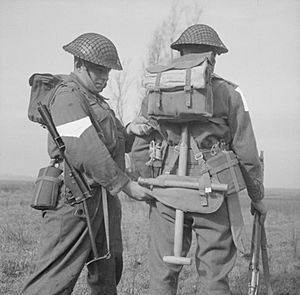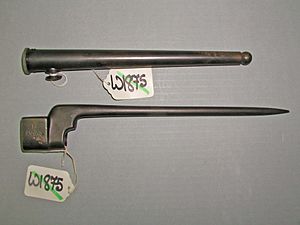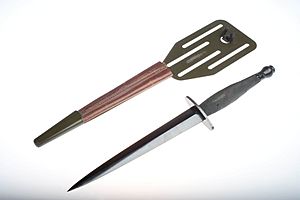List of British military equipment of World War II facts for kids
The Second World War (1939-1945) saw many countries fighting across the globe. Great Britain and its allies, including countries from the Commonwealth of Nations like Australia and India, used a wide range of military equipment. Most of their gear came from Britain itself. However, some Commonwealth countries also created their own unique weapons, like the Owen gun from Australia. This list explores some of the main equipment used by British forces during this important time in history.
Contents
Uniforms and Protective Gear
British soldiers wore special uniforms and protective gear to keep them safe and ready for battle.
Helmets
- MKl* and MKll "steel or bowl style helmet": These helmets were introduced in 1938. They were designed to protect soldiers' heads from shrapnel and falling debris.
- Mk III "Turtle" helmet": This helmet came out in 1944. It had a different shape, often called the "turtle" helmet, offering improved protection.
- Helmet Steel Airborne Troop: This special helmet was made for airborne forces, like paratroopers. It was designed to be lighter and more comfortable for jumps.
Berets
Berets are soft, round, flat-crowned hats. They replaced the older field service caps for some units. Different colours showed which unit a soldier belonged to.
- Green beret: Worn by the famous British Commandos, who were special forces.
- Maroon beret: From 1942, this was worn by airborne units, like paratroopers.
- Tan beret: The Special Air Service (SAS), another special forces group, wore this from 1942 to 1944.
- Black beret: Armoured units, including the Royal Tank Corps, wore the black beret from 1924.
Uniforms
- Service Dress: This was the main field uniform at the start of the war.
- Battledress ("Uniform No. 5"): This became the standard uniform during the war. It was practical and comfortable for fighting.
- 1937 Pattern Web Equipment: This was a system of belts, pouches, and straps. Soldiers used it to carry their ammunition, water bottles, and other gear.
Knives and Bayonets
Bayonets are knife-like weapons that attach to the end of a rifle. They were used for close-quarters combat.
- Pattern 1907 bayonet: This was the standard bayonet for the SMLE No. 1 Mk III rifle, which was widely used until 1941.
- No. 4 Bayonet: This bayonet became standard for the later Enfield No. 4 Mk I rifle.
- Sten bayonet mk I: Used with the Sten Mk II submachine gun.
- No. 5 Bayonet: Another type of bayonet.
- No. 7 Bayonet: Used with the Sten Mk V submachine gun.
- Fairbairn–Sykes fighting knife: This special fighting knife was made famous by British special forces. It was designed for close-quarters combat.
- Kukri: A traditional Nepalese knife with a distinct curved blade. It was used by Gurkha soldiers serving with the British Army.
Vehicles
The British Army used many types of vehicles, especially tanks and armoured cars. These vehicles were crucial for moving troops and fighting on the battlefield.
- You can find more details about these vehicles in articles like British Commonwealth armoured fighting vehicles of World War II.
The Royal Navy, Britain's navy, was one of the largest in the world. It used many different types of ships to protect convoys, fight enemy navies, and support land operations.
- To learn more about the ships, you can look at List of Classes of British ships of World War II.
Aircraft
The Royal Air Force (RAF) played a vital role in the war, from defending Britain in the Battle of Britain to bombing enemy targets.
- Many different aircraft were used, including fighters and bombers. You can find more information in List of aircraft of the United Kingdom in World War II.
- The Fleet Air Arm also had its own aircraft for naval operations.
Radar Technology
Radar was a new and very important technology during World War II. It helped detect enemy aircraft, ships, and even guide anti-aircraft guns.
Ground Radar
- Chain Home: This was an early warning radar system. It helped Britain detect incoming enemy aircraft during the Battle of Britain.
- Chain Home Low: A radar system designed to detect low-flying aircraft.
- AMES Type 7: A ground-controlled interception radar.
- GL Mk. I radar and GL Mk. III radar: These were "gun laying" radars. They helped anti-aircraft batteries aim their guns accurately at enemy planes.
Aircraft Radar
- Monica (radar): A tail warning radar fitted to bombers. It warned the crew if an enemy fighter was approaching from behind.
- H2S (radar): This radar was fitted to bombers. It allowed them to "see" the ground below, even through clouds or at night, to find targets.
- AI Mk. IV radar and AI Mk. VIII radar: These were "airborne interception" radars. They were fitted to fighter planes to help them find enemy aircraft in the dark or bad weather.
- ASV Mark II radar and ASV Mark III radar: These were "air-to-surface vessel" radars. They were used by aircraft to detect enemy ships and submarines.
Missiles and Bombs
British forces used various types of bombs, especially from their aircraft, to attack enemy targets.
Aerial Bombs
Bombers carried different kinds of bombs depending on the target. These included general-purpose bombs, armour-piercing bombs, and incendiary (fire-starting) bombs.
Cartridges and Shells
A cartridge is a single unit of ammunition for a firearm. It contains the bullet, propellant, and primer.
- .303 British: This was a very common cartridge. It was used for standard British rifles and light machine guns.
- .38 S&W: This cartridge was used for standard issue revolvers, which are handguns.
- 9×19mm Parabellum: This cartridge was used for standard issue submachine guns, like the Sten gun.
See also
- List of equipment used in World War II
- List of common World War II infantry weapons






